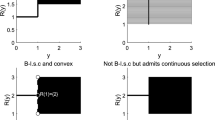Abstract
In this paper a definition is proposed for the concept of shadow prices in nonconvex programming. For a nonlinear program with equality and inequality constraints, existence of these prices and bounds for their possible values are obtained under the Mangasarian—Fromowitz regularity condition. Their exact values and some continuity properties are obtained under the more restrictive linear independence regularity condition. A definition of equilibrium prices is also proposed. Under convexity assumptions, all definitions and results coincide with those already known on this subject in convex programming.
Similar content being viewed by others
References
M.L. Balinski and W.J. Baumol, “The dual in nonlinear programming and its economic interpretation”,The Review of Economic Studies 35 (1968) 237–257.
A.V. Fiacco and G.P. McCormick,Nonlinear programming: Sequential unconstrained minimization techniques (Wiley, New York, 1968).
J. Gauvin, “A necessary and sufficient regularity condition to have bounded multipliers in nonconvex programming”,Mathematical Programming 12 (1977) 136–138.
J. Gauvin, “The generalized gradient of a marginal function in mathematical programming”,Mathematics of Operations Research 4 (1979) 458–463.
J. Gauvin and J.W. Tolle, “Differential stability in nonlinear programming”,SIAM Journal on Control and Optimization 15 (1977) 294–311.
E.G. Gol'stein,Theory of convex programming, Translations of Mathematics Monographs, Vol. 36 (American Mathematical Society, Providence, RI, 1972).
F.J. Gould and S. Howe, “A new result on interpreting Lagrange multipliers as dual variables”, Technical report no. 738, The Institute of Statistics, University of North Carolina (Chapel Hill, NC, 1971).
G. Hadley,Nonlinear and dynamic programming (Addison-Wesley, Reading, MA, 1964).
L.V. Kantorovich, “Mathematics in economics: Achievement, difficulties, perspectives”,Mathematical Programming 11 (1976) 204–211.
T.C. Koopmans, “Concepts of optimality and their uses”,Mathematical Programming 11 (1976) 212–228.
D.G. Luenberger,Introduction to linear and nonlinear programming (Addison-Wesley, Reading, MA, 1973).
E.J. McShane and T.A. Botts,Real analysis (D. Van Nostrand, New York, 1959).
R.T. Rockafellar,Convex analysis (Princeton University Press, Princeton, NJ, 1970).
R.T. Rockafellar, “Greedy prices: A saddle point condition characterizing optimality in general nonlinear programming”, Lecture given at the IX international symposium on mathematical programming, Budapest, August 23–27 (1976).
P.A. Samuelson,Foundations of economic analysis (Harvard University Press, 1948).
A.C. Williams, “Nonlinear activity analysis and duality”, in: H.W. Kuhn, ed.,Proceedings of the Princeton symposium on mathematical programming (Princeton University Press, Princeton, NJ, 1970) pp. 163–177.
W.I. Zangwill,Nonlinear programming: A unified approach (Prentice Hall, Englewood Cliffs, NJ, 1969).
Author information
Authors and Affiliations
Additional information
This research was supported by the Natural Sciences and Engineering Research Council of Canada under Grant A-9273.
Rights and permissions
About this article
Cite this article
Gauvin, J. Shadow prices in nonconvex mathematical programming. Mathematical Programming 19, 300–312 (1980). https://doi.org/10.1007/BF01581650
Received:
Revised:
Issue Date:
DOI: https://doi.org/10.1007/BF01581650




